8. The Tobacco Industry's Response
The organizational and program design barriers faced by Proposition 99's Tobacco Control Program would have been hard for any new program to overcome. But, unlike traditional public health programs that involve attacking bacteria or viruses, tobacco control advocates were dealing with an intelligent and rapidly evolving adversary—the tobacco industry. Far from sitting quietly while the new program was put in place, the tobacco industry undertook a major effort to dissect the program, to identify its strengths and weaknesses, and to shift money away from its strengths. The tobacco companies appreciated the importance and effectiveness of two parts of the California program—the media campaign and the local health department programs—well before the health groups had convincing evidence that these programs worked. The industry was not worried about how the schools were spending their Proposition 99 money.
The Industry and the Media Campaign
In the first authorizing legislation (AB 75), the tobacco industry tried to prevent any of the education money from being spent on an anti-tobacco media campaign. They hired dozens of lobbyists to kill off the media campaign, but failed because their effort was so obvious and heavy-handed. They would not make this mistake again; future efforts against the media campaign would be conducted through intermediaries.
After the media campaign hit the airwaves on April 10, 1990, the tobacco companies complained loudly in the press that the advertisements were tasteless and a waste of money and that they were “political” rather than “educational.” According to the Los Angeles Times,
“They pitched Prop. 99 as: `We want to reach under-aged children. We want to educate children to the purported health effects of smoking,'” said Thomas Lauria, a spokesman for the Tobacco Institute, a Washington-based industry group… .
He said he had not seen the state's anti-smoking ads and that industry leaders would view the ads before deciding whether to respond further.
But, he said: “These ads sound like they are trying to lay the groundwork for a next phase of a political agenda, which is to ban advertising from cigarette companies. These people are on a long march toward prohibition of tobacco.”[1]
The Tobacco Institute briefly considered a lawsuit to stop the media campaign and consulted with both Covington and Burling (its law firm in Washington, DC) and California legal counsel. But the institute decided that a lawsuit against the media campaign would be a tactical error and that “there is no basis for a suit which would have a realistic chance of success.”[2] Within RJ Reynolds, H. E. Osmon put it more bluntly: “I believe that we should take no overt legal action. It increases the rhetoric, sustains the story, and, if we lose, it would be a major embarrassment.”[3] The institute had also considered a counteradvertising campaign but rejected it: “If the industry attempts to meet the Department of Health Services head on in the media, the controversy is likely to shift from the advertisements to the industry.”[3]
On April 11, 1990, the day after the media campaign started in California, Samuel D. Chilcote, Jr., president of the Tobacco Institute in Washington, DC, sent a memo to his executive committee, with copies of the “Industry Spokesmen” ad and the other broadcast and print advertisements attached, describing the Tobacco Institute's three-pronged approach for dealing with the California campaign: “(1) Encourage California legislative leaders to intervene, (2) Through third party allies, attempt to convince Health Services head [Ken] Kizer to either pull or modify the current advertisements, (3) Encourage the Governor to intervene against the current advertisements” (emphasis added).[4] Using sympathetic legislators to attack the funding and content of the media campaign while pressuring the administration to channel the campaign into messages acceptable to the industry would remain the industry's strategy against the media campaign throughout the history of Proposition 99.
Chilcote went on to describe the tobacco industry's legislative efforts to eliminate the media campaign by putting the Proposition 99 funds to other “acceptable” uses. While acknowledging the loss on AB 75, he was clearly anticipating the next battle over authorization as another opportunity to shut down the media campaign, working with the industry's allies who wanted to see the money going to medical services:
Despite Herculean efforts [on AB 75], our goal of completely eliminating the media dedication was not met. But through our work, the media component was sliced to $14.3 million for fiscal year 1989-90. Another $14.3 million is allocated for fiscal year 1990-91, for a total to date of $28.6 million.
The industry has been approached by representatives of county governments, as well as physician groups, expressing an interest in working with us so that they may receive monies that are currently earmarked to the media “education” campaign. These avenues continue to be explored with the California State Association of Counties and the California Medical Association.[4] [emphasis added]
Chilcote described the tobacco industry's efforts to line up opposition to the advertisements in the minority community: “The black and Hispanic communities also are upset because very few Prop 99 dollars have found their way to the poor in the form of new health services. A substantial amount of the Prop 99 revenues are being use [sic] to `replace' previous state funding from other sources.”[4]
The industry was also planning to conduct its own focus group research “in order to support our position that the advertisements are more propaganda than information.”[4] There was, in fact, a chance that people would not consider the advertising as “education.” The innovative nature of the California media campaign was based on the recognition that merely providing information about health-compromising behaviors did little to reduce smoking. Heavily promoted by the industry as attractive, glamorous, and necessary for social acceptance, smoking had to be shown instead as a deadly, addictive habit foisted on people by a cynical industry with seemingly endless amounts of money to spend on lying about its product. The campaign was thus designed to “unmarket” smoking rather than inform people about the health effects of smoking, which traditional health educators thought an “education” campaign was supposed to do. If the industry could demonstrate that the public did not see the advertisements as “educational,” then it might have additional ammunition to take to the Legislature.
On April 18, 1990, Chilcote sent another, more detailed memo to members of his Executive Committee providing a “further update on
In the week between these two memos, the Tobacco Institute realized that Kizer of DHS would fight to protect the campaign and that Governor George Deukmejian, while not agreeing with the specifics of the campaign, would back him up:
After analysis from our California team, it is clear that our efforts should center on the first two strategies [the Legislature and other groups], with the hope that these efforts can have some effect on the other two strategies.
The reasons for this approach are (1) Dr. Kizer is not likely to pull or modify the advertisements without strong pressure from the Administration; (2) as a “lame duck,” the Governor is not likely to get into a public sparring match with Dr. Kizer, even though he disagrees with the Department of Health Services' attack approach with the anti-tobacco advertisement.[2]
Seeing little chance of success with the Deukmejian administration, the industry decided to concentrate its efforts on getting the Legislature to eliminate funding for the media campaign.
By April 18, the industry had made more than one hundred contacts about diverting money away from the media campaign and was already working to create a “focused coalition willing to take the lead in an effort to end funding for media from Prop 99 taxes and redirect it elsewhere.”[2] In addition to the county supervisors and the California Medical Association (CMA), this coalition was to include the black and Hispanic communities, the Western Center for Law and Poverty, the Asian community, hospital groups, and business groups. According to Malmgren,
Intelligence to date shows a range of reasons why these groups are ill at ease and concerned with the advertising campaign. Black concerns, for example, vary from resentment at the denigrating nature of the advertisements, to concern that Prop 99 dollars are not being channeled to pressing health care needs for minority groups, to the fact that Prop 99 media dollars are not being funneled to black-owned media. …
The doctor and hospital segment appears to believe the media funds would be better spent to pay medical costs.[2] [emphasis added]
On May 3, New York-based KRC Research delivered a public opinion survey regarding the media campaign to Covington and Burling,
To engage in a public debate over this advertising campaign (i.e., whether it is an appropriate use of state funds, and whether it will actually be an effective deterrent to smoking) will most likely serve only to escalate the controversy.
We believe it will be more effective for the Tobacco Institute not to engage in this battle, but rather to attempt to focus attention on the ways that people would prefer to see state money spent in the pursuit of improved public health.
To this end, we believe that the questions we develop for use in Field's California Poll should be designed to identify the types of health care and educational programs that people believe will be more effective and that they would prefer to see funded.[5]
The Field California Poll is a widely regarded survey whose results are always made public, regardless of who commissions the survey. The fact that the industry did not pursue a Field California Poll suggests that it was uncertain of getting the answers it wanted.
The qualitative analysis of the advertisements was based on a series of eight focus groups. The report concluded,
The atmosphere in California appears to be rapidly evolving into an anti-smoking environment. This “reality” is accepted by smokers and advocated by non-smokers. Smokers believed that smoking is potentially harmful, yet they cannot quit and cannot be forced to do so. However, they want their children to be smoke free.
Neither smokers nor non-smokers voiced strong opposition to Proposition 99. They all empathized with people who could not afford healthcare, and supported making it more accessible to the poor. There was general support for the $221 million education campaign, and a mixed reaction (though
― 152 ―only one or two respondents were strongly opposed) to $28 million being spent on an anti-smoking media campaign.As for the five commercials, they were perceived to have slight to no impact on the marketplace. These ads will not change smokers' behavior. The ads do, however, add to the general anti-smoking environment.
It is important to understand that the commercials' lack of appeal was not based on the idea that government infringed on the rights of smokers. Rather, opposition was based on the perception that these ads were not strong enough.
Respondents generally agreed that an effective non-smoking ad campaign should be more “medically” informative and visually explicit.[6] [emphasis in original]
The report was not encouraging to the tobacco industry, since it suggested that the public wanted an even stronger anti-tobacco campaign.[4]
On May 14 Walter N. Woodson, the Tobacco Institute's vice president of state activities, wrote to Chilcote advising him that the industry was moving ahead with efforts to shift the media money to specific service providers:
We are working with several groups who share our interest in having the funds targeted to real health care concerns. Among them:
- California Health Foundation
- Black Health Network
- California Rural Counties Association
- California Hospital Association
- California Medical Association
- A just-formed, and as yet unnamed, confederation of most state minority health organizations[7]
By November, the Tobacco Institute seemed to be making some progress in this strategy. A report noted that “prompted by minority health groups such as the Watts Health Foundation and the Black Health Network,” two Democratic legislators “attempted to reopen the funding of the media program and dedicate the funds to other programs benefitting their communities.”[8] The effort was stopped in a conference committee by Republicans who would not support the effort without a promise of support to amend Proposition 98, which required that 40 percent of the state budget go to education. The Democrats refused to reopen Proposition 98, so this effort to divert the media campaign money died.[8]
The industry strategy then focused on the 1991-1992 legislative session, when a new piece of implementing legislation would be needed for
“It's the Law”
While most local ordinance activity in California was concentrated on clean indoor air at this time, there was also growing interest in passing local ordinances that would make it harder to sell cigarettes and other tobacco products to children. In response to this development, which was matched by a similar climate in other states for reducing youth access to tobacco products, the Tobacco Institute developed “It's the Law.” This program provided stickers that merchants could post to warn consumers that it was illegal to sell cigarettes to children. It was designed to head off laws that could impose meaningful enforcement provisions or penalties on retailers or tobacco companies.
By 1991, the tobacco industry was actively planning ways to use its “youth initiative” to undermine Proposition 99. Philip Morris intended to introduce legislation in several states to address sales penalties and vending machine restrictions in terms that were acceptable to the company.[9] Despite its ostensible goal, however, the program had nothing to do with decreasing the youth smoking rate: “The ultimate means for determining the success of this program will be: (1) A reduction in legislation introduced and passed restricting or banning our sales and marketing activities; (2) Passage of legislation favorable to the industry; (3) Greater support from business, parent and teacher groups.”[9] Although the tobacco industry claimed to have designed the program “to promote our objectives in preventing youth smoking while protecting our sales and marketing practices,”[10] its main purpose was clearly the latter.
The youth strategy was an important aspect of undermining Proposition 99. In a December 21 memo. T. C. Harris of RJ Reynolds wrote, “I believe that a concentrated implementation of the Youth Non-Smoking Program is a critical component, as it gives us a credible way to show that the Proposition is unnecessary, whether we do it via advertisements or in negotiations” (emphasis in original).[11] By 1991, the Tobacco Institute was also interested in how it could use the youth issue to gain the ear of elected officials. In May, Walter Woodson of the Tobacco Institute, was preparing a mailing to 6,000 California elected officials containing a press release on the Tobacco Institute's youth smoking initiative and a press kit on “It's the Law.” According to Woodson,
The industry is being hit hard at the local level in California this year. We currently are facing more than forty local ordinances, many of which address more than one issue. As might be expected, a number of these bills have been introduced under the premise that youth have easy access to tobacco products. …Sending the youth materials to all elected officials in the state may help to alleviate the surge of introductions for the time being, and provide us with a vehicle to go in and meet with some of the representatives there. Additionally, such a mailing could assist with efforts to achieve broad distribution of the youth program throughout the state.[12]
In other words, the purpose of the program was to head off legislation restricting tobacco marketing.
The Industry and the Schools
In contrast to its reaction to the anti-tobacco media campaign, the tobacco industry seemed satisfied with the school-based programs that the California Department of Education (CDE) was running. Indeed, some schools were actually using “educational” materials produced by the tobacco industry, even though these materials were widely viewed by tobacco control advocates as subtly encouraging smoking. CDE, unlike DHS, did not understand that the tobacco industry had to be treated as an adversary.
RJ Reynolds hired the consulting firm of Stratton, Reiter, Dupree & Durante from Denver to provide a thorough analysis of the structure of TCS, CDE, and the Proposition 99 anti-tobacco program.[13] By April 1991, the firm had concluded that the program in the schools did not threaten the industry and perhaps represented an opportunity. In a memorandum summarizing his conversations with the firm's Rick Reiter, Tim Hyde of RJ Reynolds wrote,
$72,000,000 [of the Health Education Account money] goes to the Department of Education for K-12 classroom uses. The specific allocation of this money is fairly straightforward. It is primarily being used for training and materials to be included as a tobacco supplement to drug and AIDS curriculum. There are also a few odds and ends, such as numerous “tobacco-free” contests and the like. Rick's preliminary suggestion is for us to take advantage of the review-committee opportunity to get industry personnel involved in the overall DOE decision-making process because the goals of this program are consistent with our own views on youth smoking.[14] [emphasis added]
The industry's consultants recognized the schools' lack of commitment to doing something about tobacco with the new Proposition 99 money. The report comments,
Coincidently [sic], it wasn't until after passage of Prop 99 that CDE suddenly discovered tobacco prevention as being tantamount to promotion of healthy lifestyles for children. In reviewing HKHC [Health Kids, Healthy California] workshop materials developed prior to 1990, seemingly every health-related issue at the school level was emphasized except tobacco. …With the recent discovery of tobacco as a health threat came the discovery of a funding mechanism to supplement the newly introduced HKHC comprehensive health program. This co-mingling effort of shared resources suggests that CDE tobacco excise revenues are being used to supplement activities related to drug and alcohol prevention and cessation. These two areas are the priority health and safety concerns in the public schools.[13] [emphasis added]
The report was uncertain about the degree to which tobacco had, in fact, become part of the schools' program and suggested that the cutbacks could “be of some relief to the industry; funds are being shifted to areas outside of the Health Education Account, and CDE will continue spreading [the reduced allocation] among drug and alcohol programs rather than tobacco exclusively.”[13] The chief threat posed by the schools, according to the report, was that schools had helped frame the smoking issue as a health issue, which the tobacco industry had consistently tried to avoid in California. When smoking was framed as a health issue, not one of individual choice or taxation, the industry generally lost its political battles.
The tobacco industry had its own strategy for schools. It produced curricula designed to “educate” kids about tobacco without clearly discussing the health dangers of smoking or the fact that it killed adult smokers. RJ Reynolds produced “Right Decisions, Right Now”; the Tobacco Institute produced “Tobacco: Helping Youth Say No,” originally entitled “Helping Youth Decide.” Both packages were slickly produced and were free to schools. Rather than presenting tobacco as a dangerous product that should be avoided by everyone, these materials emphasized “the choice to smoke” and that “smoking was for adults.” The industry justified their materials with the objective of ensuring that “minors receive support and education in regard to smoking being an adult practice.”[9] These messages are consistent with traditional tobacco industry advertising themes—that smoking makes kids look grown up—and even convey the notion that smoking is a desirable “forbidden fruit” for youth.[15-17] The curriculum materials also seemed to serve an important political purpose for the industry: they supported the argument that there was no need for government to spend tax dollars to reduce smoking; the industry would take care of everything.
In the early years of Proposition 99's Tobacco Control Program, educators
White was not the only person from the schools requesting these materials. Schools all over the state requested copies of the tobacco industry's “educational” materials, including one director of a Healthy Kids regional center.[18]
Conclusion
The DHS anti-smoking advertising campaign clearly identified the tobacco industry as a threat to the public health, and the industry reacted quickly and vigorously to develop a political strategy to fight the media program. The industry learned from its defeat in the AB 75 battle that it would have to stay in the shadows and work through surrogates to fight the media campaign in the Legislature.
The schools did not threaten the industry. While some efforts to place tobacco industry materials were rebuffed in schools, the CDE leadership showed little commitment to anti-tobacco efforts. Many were even willing to cooperate with the industry in distributing its curricula, despite the fact that this material was widely criticized in the public health community. For the industry, the Proposition 99 programs in the schools posed no threat and even presented an opportunity to advance its own legislative strategy. Industry documents contained no strategy to kill off the schools program.
The media campaign and the local government programs were not so fortunate. The fight against anti-tobacco efforts at the local level, in fact, became a central piece of the industry strategy, one in which the industry would invest substantial time and money.
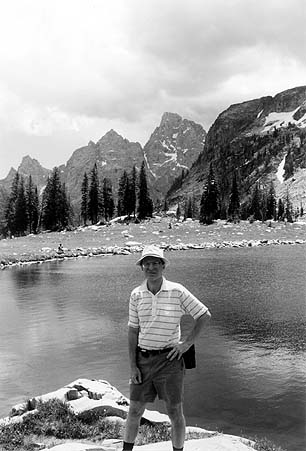
Peter Hanauer, one of the early leaders of the nonsmokers' rights movement in California, viewed secondhand smoke as an environmental problem, as opposed to a medical one. (Photo courtesy of P. Hanauer)
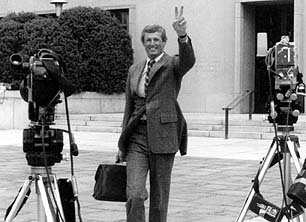
Paul Loveday joined with Hanauer to provide the core leadership of the 1978 and 1980 efforts to enact clean indoor air laws in California thorugh the initiative process. While the tobacco industry defeated these initiatives, non-smokers' rights advocates developed the political skills and strategies to defeat the tobacco industry at the local level. The photo shows Loveday leaving the US Court of Appeals in Washington after arguing that the Federal Communications Commission should require disclosure of tobacco industry sponsorship of advertisements in political campaigns. (Photo courtesy of P. Loveday)
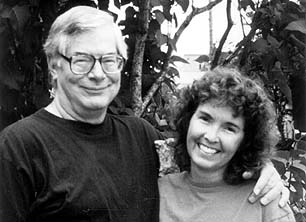
Curt Mekemson (shown here with his wife Peggy), working with environmentalist Gerald Meral, originated the idea of raising the tobacco tax and allocating a portion of the revenues to tobacco control. This idea was realized in Proposition 99. (Photo courtesy of C. Mekemson)
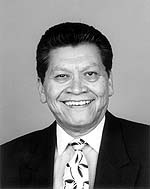
Tony Najera, the American Lung Association's lobbyist, joined Mekemson and others in developingand passing Proposition 99. Najera, a continuous presence in the Capitol, led insider efforts within the Legislature to implement tobacco control programs. (Photo courtesy of Tony Najera)
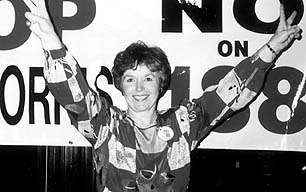
Carolyn Martin, a longtime American Lung Association volunteer, played a leading role in passing Proposition 99 and organizing the early opposition to the Philip Morris initiative, Proposition 188. She also served as the first chair of the Tobacco Education Oversight Committee. (Photo courtesy of C. Martin)
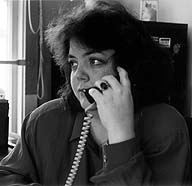
Julia Carol rose from secretary of Americans for Nonsmokers' Rights to become its executive director and the champion of local grassroots i efforts to protect nonsmokers. She also played a leading role in the 1996 public campaign to rescue Proposition 99 by moving from insider to outsider strategies. (Photo courtesy of J. Carol)

John Miller, chief of staff to Senator Diane Watson and the Senate Committee on Health and Human Services, was the primary inside player within the legislative staff who worked to support tobacco control efforts. (Photo courtesy of J. Miller)
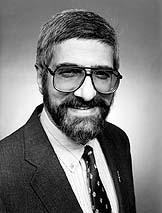
Dileep Bal, the head of the Department of Health Services Cancer Control Branch, which includes the Tobacco Control Section, provided the vision and bureaucratic savvy that helped California develop the most aggressive tobacco control program in the nation. (Photo courtesy of D. Bal)
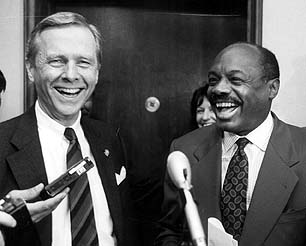
Republican Governor Pete Wilson (left) and Democrat Assembly Speaker Willie Brown (right) clashed on many issues but worked together to gut California's tobacco control program. (Photo by Rich Pedroncelli)
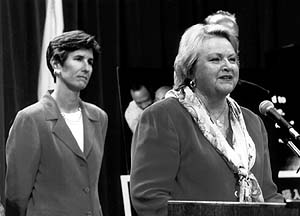
Sandra Smoley (right), secretary of health and welfare in the Wilson administration, voted against the Sacramento clean indoor air ordinance when she was a member of the Sacramento Board of Supervisors. She took the lead in forcing the California Tobacco Control Program to tone down attacks on the tobacco industry. Kimberly Belshe (left), director of the Department of Health Services, campaigned against Proposition 99 for the tobacco industry in 1988, then occasionally advocated for the Tobacco Control Program behind the scenes, but ultimately implemented administration policies to tone down the campaign. (Photo courtesy of California Department of Health Services)
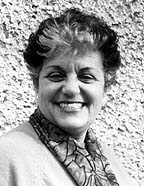
Jennie Cook, an active volunteer with the American Cancer Society who rose to become the national chair of the board, worked on tobacco control activities in California and became the second chair of the Tobacco Education and Research Oversight Committee. Cook generally avoided confrontation with the administration, but eventually took the lead in using TEROC as a platform to pressure the Wilson administration to strengthen the anti-tobacco media campaign. (Photo courtesy of J. Cook)
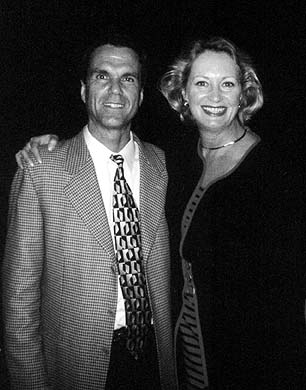
American Heart Association lobbyist Mary Adams (right) convinced Executive Vice President Roman Bowser (left) to join in an aggressive public campaign to force the California Medical Association away from the tobacco industry and hold Governor Pete Wilson accountable in the successful drive to restore funding for Proposition 99. (Photo courtesy of M. Adams)
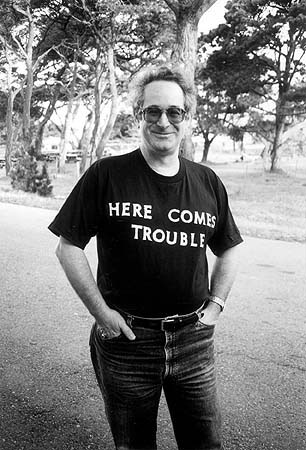
The staff of the Department of Health Services Tobacco Control Section gave UCSF Professor Stanton Glantz a t-shirt labeled “Here Comes Trouble” in honor of his role—both in public and behind the scenes— in pressuring the administration to strengthen the tobacco control program.
Notes
1. Roan S. “State to launch anti-smoking ad campaign” . Los Angeles Times 1990 April 10;A1.
2. Malmgren KL. “Memorandum to Samuel D. Chilcote, Jr. April 18, 1990” . Bates No. TIMN 298437/298420W.
3. Osmon HE. “Memo to W. E. Ainsworth and R. L. Mozingo. April 12, 1990” . Bates No. 50760 3741/3742.
4. Chilcote SDJ. “Memorandum to the members of the Executive Committee. April 11, 1990” . Bates No. TIMN 423498/423504.
5. KRC Research. “Memo to Stanley Temko, Covington & Burling, re: California quantitative research. New York: KRC Research & Consulting. May 3, 1990” . Bates No. TIMN 355366/355370.
6. KRC Research. “Qualitative research report: Reaction to California's Proposition 99 and its 1990 anti-smoking media campaign.” New York: KRC Research & Consulting, 1990 May. Bates No. TIMN 334989/335167.
7. Woodson WN. “Memo to Samuel D. Chilcote, Jr., re: California advertising situation. May 14, 1990” . Bates No. TIMN 355359/355360.
8. Tobacco Institute (?). “California anti-tobacco advertising program. November 1, 1990” . Bates No. 50779 3734/3735.
9. Slavitt JJ. “Memo to Pat Tricorache re: TI youth initiative. February 12, 1991” . Bates No. 2500082629.
10. Slavitt JJ. “Memo to William I. Campbell. March 1991” . Bates No. 2500082631/2634.
11. Harris TC. “Memorandum to T. N. Hyde re: Planning meeting on impending “Prop 99” efforts. December 20, 1991” . Bates No. 51199 9020x.
12. Woodson W. “Memorandum to Marty Gleason. May 13, 1991” . Bates No. TIMN 378297.
13. Stratton, Reiter, Dupree & Durante. “Report to R. J. Reynolds Tobacco on the Tobacco Control Plan, State of California.” Denver, June 14, 1991. Bates No. 51319 3999/4061.
14. Hyde T. “Memo to Tommy Griscom, Tom Ogburn, Roger Mozingo, Jim O'Mally, and Mark Smith, re: Stratton & Reiter's California research project. April 4, 1991” . Bates No. 50777 7860/7863.
15. DiFranza JR, Godshall WT. “Tobacco industry efforts hindering enforcement of the ban on tobacco sales to minors: Actions speak louder than words” . Tobacco Control 1996;5(2):127-131.
16. DiFranza JR, Savageau JA, Aisquith BF. “Youth access to tobacco: The effects of age, gender, vending machine locks, and “It's the Law” programs” . Am J Pub Health 1996;86(2):221-224.
17. DeBon M, Klesges RC. “Adolescents' perceptions about smoking prevention strategies: A comparison of the programmes of the American Lung Association and the Tobacco Institute” . Tobacco Control 1996;5(1):19-25.
18. Tobacco Institute. “Order form for “Helping Youth.”” Washington, DC, 1993, Bates No. TIMN 447189/447215.